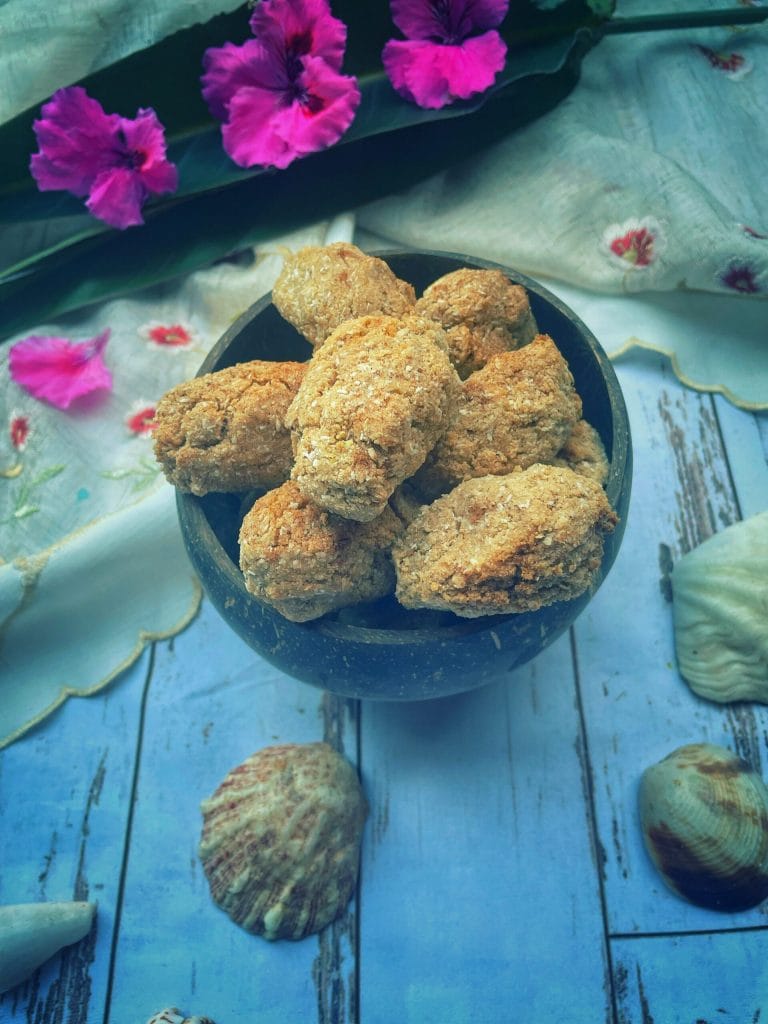Bolinhos de Estudante, are a traditional sweet from the state of Bahia, Brazil, made with manioc flour (granulated tapioca), fried with coconut, sugar, and cinnamon, ideal for breakfast or a snack.
Naturally gluten-free.
Although served in many restaurants and patisseries, the most traditional place to find them is the tabuleiro da baiana do acarajé.
In the 20th century, Bahian women opened a shop at the school gates, where their sweets were a hit.
One of their favorite sweets was tapioca cakes with grated coconut, cooked on the spot and eaten hot by boys and girls.
According to the book, “Cozinhando História – receitas, histórias e mitos de pratos afrobrasileiros”, by Josmara Fregoneze, Marlene de Jesus da Costa, and Nancy de Souza (Ebomi Cici), this sweet became known as the “student cake”.
In the video, you’ll find the version with “frying” in an air fryer.

- Difficulty: Medium
- Cost: Cheap
- Rest time: 1 Hour 30 Minutes
- Preparation time: 10 Minutes
- Portions: 18 pieces
- Cooking methods: Frying
- Cuisine: Brazilian
- Seasonality: All seasons
Ingredients
- 7.94 oz granulated tapioca
- 0.42 cup boiling water
- 1.76 oz grated coconut
- 3.53 oz sugar (+ for decoration)
- 0.85 cup coconut milk (or milk)
- 1 pinch salt
- to taste ground cinnamon
Steps
In a large bowl, combine the granulated tapioca, boiling water, grated coconut, sugar, and salt.
Mix well with a spoon until you get a homogeneous mixture.
Add the coconut milk or milk and continue to mix until the mass becomes uniform.
Cover the bowl with plastic wrap and let it rest at room temperature for about 1 and a half hours, allowing the tapioca to absorb the liquids.
After resting, lightly knead the mixture with your hands for about 3 minutes until you get a moldable consistency.
Take small portions of dough and form cylinders.
Heat the oil in a deep pan and fry the bolinhos until they are golden and crispy.
Drain them on paper towels and, while still hot, roll them in a mixture of sugar and cinnamon.
The book “La cucina baiana di Jorge Amado” – or the recipe book by Pedro Archanjo contains texts and gastronomy based on recipes and stories, stating that student cakes are better known as punheta (meaning male autoerotism), as indicated in Jorge Amado’s work, “O Sumiço da Santa“.
The gastronomic attraction with sexual connotations was the subject of one of Amado’s adventures. In the book “O Sumiço da Santa”, Amado mentions the famous punheta, in an appetizing passage!
FAQ (Questions and Answers)
What is “tabuleiro da baiana do acarajé“?
The tabuleiro da baiana do acarajé is the name given to the table or cart on which the Bahian woman displays and sells her products, mainly the acarajé and its side dishes.
It is a symbol of Bahian culture and represents Afro-Brazilian cuisine and tradition.
What is on the Bahian tray:
Acarajé: made with black-eyed peas, fried in palm oil.
Side dishes: vatapá, caruru, dried shrimp, salad, pepper, and other condiments.
Other choices: abará, cocada, student cake, and other options may vary depending on the Bahian woman.
It is an intangible cultural heritage of Brazil, recognized by IPHAN.
It represents the strength and tradition of Bahian women, guardians of Afro-Brazilian cuisine.
It is an important driver of the local economy and a source of income for many families.
Acarajé, in particular, has a religious significance in Candomblé, being offered to orixás.

